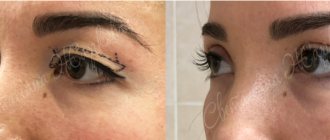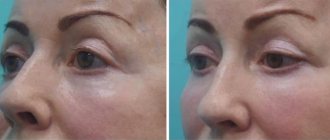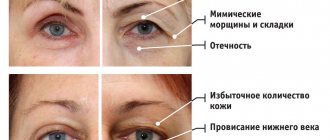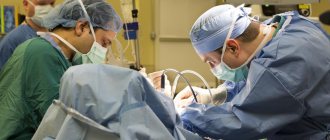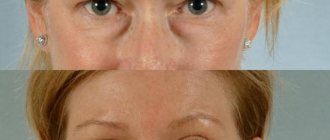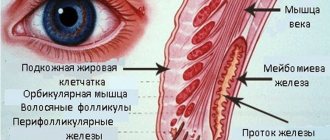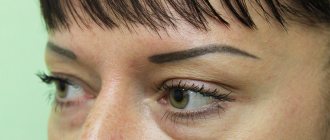Laser blepharoplasty is a procedure aimed at correcting the skin of the eyelids. Over time, the skin around the eyes becomes less elastic, resulting in a tired or “heavy” look. The problem can be eliminated through plastic surgery methods. But, like any other operation on the human body, this procedure has many disadvantages - a long rehabilitation period, the negative effects of anesthesia. In some cases, in the field of cosmetology, laser blepharoplasty may be a reasonable alternative. With its help, eyelid correction is carried out as quickly and less painlessly as possible. The procedure will take up to 30 minutes, complete healing will occur in 1 week, and the results will last for up to one year.
Laser vs scalpel: 10 important advantages
- There is no need to go to the hospital.
- Laser blepharoplasty takes less time.
- Although it is traditionally done under general anesthesia, in some cases local anesthesia can be used.
- The laser beam is thinner than steel and leaves much smaller cuts.
- The surgeon sets the depth of beam penetration using a computer, and therefore acts with precision that is difficult to achieve with a scalpel even for the most experienced specialist.
- Simultaneously with excision of tissue, the laser cauterizes it, which helps reduce blood loss and reduces the risk of infection in the wounds.
- Bruising and swelling - natural consequences of surgery - are less pronounced after laser blepharoplasty, and the healing process itself is faster.
- Postoperative scars are almost invisible. They are definitely inferior to the marks from the intervention of a surgical scalpel.
- The result of the operation is in no way inferior to conventional plastic surgery, and sometimes even surpasses it.
- The laser beam activates regenerative processes in tissues, causes cells to actively regenerate and promotes skin rejuvenation.
There is one noticeable disadvantage of laser blepharoplasty – a higher price.
Laser blepharoplasty of the upper and lower eyelids - the essence of the technique
Laser blepharoplasty (reviews about it can be found on general information sites, as well as personal Internet resources of clinics and practicing surgeons) of the upper and lower eyelids is usually recommended for patients who are prohibited from traditional plastic surgery of overhanging skin in the eye area. The most common cause of loose skin is weakening of the eye muscles.
Ignoring the changes that occur can be fraught with a significant deterioration in vision or even loss of vision.
The essence of the operation to eliminate drooping eyelids is short-term multiple exposures of the laser to the skin, without grossly violating the integrity of nearby areas of the “working area”. Laser blepharoplasty is performed using multifunctional complexes capable of reproducing erbium light waves with a size of about 2940 nm.
The penetration depth of such a beam does not exceed 1 micron, which ensures short-term restoration of the skin after the intervention, and also minimizes the risk of residual scars.
The very effect of the reproducible laser is based on its effect on the keratinized cells of the superficial layer of the skin of the eyelids . This helps stimulate the body’s natural production of collagen and elastin, which automatically results in skin rejuvenation and lifting accompanying this process.
What laser is used for blepharoplasty
Real laser blepharoplasty - that is, plastic surgery - can only be done using a CO2 laser. Its beam is capable of penetrating into the deep layers of the epithelium, making neat cuts, immediately sealing the damaged areas, and efficiently solving the problems of drooping eyelids, wrinkles and other cosmetic troubles.
The operation is performed using a CO2 laser
The erbium laser is not capable of this, however, it is also used in the care of the periorbital area of the face. It acts extremely delicately: it does not leave burns, does not require long-term rehabilitation, but it efficiently evaporates the stratum corneum from the surface of the skin and triggers regenerative processes in cells, which helps their renewal. Using an erbium laser, skin resurfacing is performed, after which the eyelids look more toned and youthful. However, in terms of the degree of impact and, therefore, the duration of the effect, it cannot be compared with CO2.
Erbium laser is often used after CO2 to smooth out the smallest marks from plastic surgery and speed up healing.
Laser resurfacing
The essence of the procedure
Laser resurfacing around the eyes involves treating the skin with light-thermal rays produced by a special device.
The equipment used is expensive and requires certain skills, so use at home is excluded.
The laser provokes microexplosions on the surface of the dermis, during which the liquid contents of the cells evaporate. Thus, it is possible to quickly and painlessly remove the dead layer of the epidermis and activate tissue regeneration. The depth of exposure and treatment scheme for each patient are selected individually.
Buyanov Sergey Yurievich (Expert Doctor):
Attachments for laser grinding are equipped with a limiter, which provides for turning off the device when the “extra zone” of irradiation is captured. For example, if you accidentally move your hand, the doctor can be sure that the conjunctiva of the eye and inner eyelid will not be damaged.
The procedure is recommended to be carried out between October and March. This is due to a decrease in solar activity and its negative impact.
Effect:
- skin healing;
- smoothing wrinkles;
- removal of scars, prevention of their appearance;
- tissue tightening.
Indications for use:
- expression and age wrinkles;
- scarring;
- bags, dark circles under the eyes;
- decreased elasticity;
- drooping of the upper and lower eyelids.
Types of laser blepharoplasty
The type of surgery depends on what part of the eyelids will be corrected and what technique the surgeon will use.
By venue
Depending on what problem needs to be solved, the upcoming operation can be divided into:
- Blepharoplasty of the upper eyelids. Excess skin is excised, the overhanging upper eyelid is lifted into place, and sagging is eliminated.
- Blepharoplasty of the lower eyelids. Bags, swelling, and fatty hernias under the eyes are removed.
- Circular blepharoplasty. This method of surgical intervention combines the first and second options and allows you to tidy up the skin in the entire periorbital area.
- Changing the shape of the eyes. Making necessary adjustments to the appearance of patients who are dissatisfied with the shape of their eyes.
- Canthopexy. Aimed at tightening the drooping corners of the eyes, returning openness and youth to the look.
By technique
Blepharoplasty techniques are constantly being developed and improved to meet two main requirements: to be safe for the patient and, if possible, not to leave noticeable scars. The surgeon’s choice of a specific technique depends on which area of the periorbital region needs correction.
Types of techniques
- The suture is placed along the edge of the lower eyelid at the eyelash line (lower eyelid blepharoplasty).
- The suture is hidden in the deep skin fold of the upper eyelid above the eye (upper eyelid blepharoplasty).
- An incision is made on the inside of the lower eyelid, after which excess muscle tissue and fat are removed. The technique is called transconjunctival or sutureless laser blevaroplasty and makes it possible to tighten sagging skin and remove bags and hernias under the eyes without leaving a trace. But it cannot cope with clearly visible age-related ptosis (tissue drooping). In such cases, more extensive intervention is required.
If the shape of the eye needs to be reshaped, the surgeon may use incisions on both the top and bottom of the eyelids.
Kinds
When choosing a specific aesthetic course, special attention is paid to the degree to which the desired result is obtained and the individual characteristics of the skin.
Depending on the initial condition of the skin, a certain type of blepharoplasty may be prescribed:
- Laser – involves deep impact on skin tissue using a laser.
- Circular – eliminates defects of the periorbital zone using the technique of simultaneous plastic surgery of the lower and upper eyelids.
- Hardware – the tightening effect is achieved due to the effect on the skin of radio waves, infrared rays, RF radiation or low-frequency electric current. The procedure is carried out using cosmetic devices.
- Injection – increased skin elasticity occurs due to the powerful effects of medications that are injected under the skin.
Each technique has its own contraindications, so an experienced cosmetologist should select a specific type of blepharoplasty.
Laser
Non-surgical blepharoplasty using a laser is an effective method of tightening the skin of the eyelids, which is a good alternative to radical methods of plastic surgery.
The popularity of this method is due to a number of advantages:
- Minimal tissue trauma.
- Low probability of hematomas.
- No scars.
- Maximum rejuvenating effect.
To carry out the procedure, exposure to one of the light emitters - erbium or carbon dioxide - can be used. In the process of laser blepharoplasty, the protein fraction of the skin is coagulated and the copy layer is polished. After this, the skin is quickly restored and regeneration processes are activated.
The final result can be assessed 8 weeks after the procedure. Using laser blepharoplasty, you can get rid of wrinkles, solve the problem of eye asymmetry, and increase eye muscle activity.
Circular
If it is necessary to correct sagging skin on the lower and upper eyelids, circular blepharoplasty is performed. Elimination of aesthetic defects can be carried out simultaneously in several directions and with the help of one procedure various problems can be solved.
Such as:
- Sagging skin on the upper and lower eyelids.
- Asymmetry of the palpebral fissures.
- Fat deposits on the upper eyelids and the formation of bags under the eyes.
- Congenital or acquired pathologies.
Non-surgical circular correction takes place without incisions in the skin. To remove excess fatty contents, punctures are performed, and the lower eyelids are lifted by fixing loose skin in special anchor areas. Blepharoplasty performed in this way allows you to achieve the maximum effect of rejuvenation and lifting through a complex procedure.
Hardware
The use of hardware cosmetology is very popular because it allows you to evaluate the results immediately after the procedure and provides a painless effect on a specific area. This completely eliminates the risk of facial deformation and tissue displacement.
Among the wide variety of types of eyelid skin tightening using hardware cosmetology, the most effective can be identified:
- RF lifting. This procedure allows you to completely get rid of swelling under the eyes using ultrasound. The device allows you to eliminate imperfections such as wrinkles, increase skin turgor, and remove hernias. The effect is achieved by contracting the muscle frame in the eyelid area.
The results of using one of the methods of non-surgical blepharoplasty - RF lifting - DROT therapy. The complex effect of laser optical thermolysis at a point level and RF radiation treatment allows you to avoid damaging the sensitive skin on the eyelids. Double-action therapy can significantly increase skin elasticity due to the active production of collagen, tighten the eyelid and eyebrow area, and smooth out wrinkles.
- Thermolifting. When areas are heated with radio wave or infrared radiation, regeneration of skin tissue occurs, due to which the surface is smoothed, swelling and swelling are eliminated.
- Thermage. As a result of radio wave exposure, there is a powerful stimulation of the production of collagen and elastin, the content of which determines the elasticity of the skin.
- Electroblepharoplasty . The device operates on the basis of electric current, producing low-frequency radiation. Thanks to heating, the processes of collagen and elastin production are activated.
All hardware methods are based on warming up the deep tissues of the skin of the eyelids. Such manipulations provide powerful lifting results and are safe.
Injection
To rejuvenate the skin and smooth out wrinkles, it is necessary to ensure a normal level of fluid in the skin tissues. Using injections, you can nourish weakened areas with useful components, enrich the skin with hyaluronic acid, phytoestrogens and amino acids.
As a result of many punctures of the skin, natural regeneration is triggered, and medications additionally saturate the tissues. After the procedure, you can notice good results: local metabolism is stimulated, wrinkles are completely smoothed out, and the skin is tightened.
Indications for surgery
Laser blepharoplasty successfully copes with such cosmetic imperfections in appearance as:
- eyelid ptosis;
- bags and hernias;
- drooping corners of the eyes;
- lack of symmetry of facial features in the middle third;
- excess tissue in the eye area, “swollen” eyelids;
- wrinkles of varying severity;
- general sagging tissue, and this applies to both skin and muscles;
- client's dissatisfaction with the shape of his eyes.
Medical indications include:
- turning of the eyelids;
- various mechanical damage to the skin and muscles in this area;
- eyeballs protruding strongly forward.
Indications and contraindications
With the help of laser blepharoplasty, patients get rid of age-related changes after 35–40 years and aesthetic imperfections. Meanwhile, there are medical indications for the procedure:
- excessive drooping of the lower or drooping upper eyelid (they impair vision);
- the presence of fatty hernias;
- drooping corners of the eyes, deformation of the eyelids and the appearance of a “heavy” look;
- facial asymmetry, different eye shapes, eye contour defects;
- the formation of deep wrinkles or crow's feet.
The procedure is also prescribed after injuries and burns.
Contraindications to laser eyelid blepharoplasty:
- individual sensitivity to laser;
- the presence of inflammation in the area of manipulation;
- oncology;
- HIV infection;
- blood clotting disorder;
- diabetes;
- somatic pathologies;
- epilepsy;
- fever;
- period of pregnancy and lactation;
- severe diseases of the cardiovascular system;
- some eye diseases and pathologies (dry eye syndrome, glaucoma, increased intraocular pressure, etc.)
- disruption of the endocrine system;
- infectious diseases.
The procedure may be delayed for other reasons that are determined individually.
Contraindications
Despite the fact that blepharoplasty is one of the minimally invasive operations and is considered uncomplicated, there are categories of patients who will have to refuse it. A clear contraindication would be:
- anemia;
- blood clotting problems;
- some diseases of the eyes (keratitis), muscle tissue (myopathy) or skin of the eyelids (blepharitis);
- pathology of the thymus gland;
- oncology;
- arterial hypertension and increased intracranial pressure.
Relative contraindications:
- inflammation of the skin of the eyelids, barley, etc.;
- colds or viral diseases;
- recovery period after another surgical intervention;
- menstruation.
Some diseases serve as a conditional contraindication. For example, diabetes mellitus puts a “veto” on blepharoplasty, but if the blood sugar level can be stabilized with a set of therapeutic measures, permission for the operation can be obtained.
How is laser blepharoplasty done?
Each case of blepharoplasty is unique in its own way. It is difficult to predict how surgery on the eyelids of a particular person will occur: here you need to take into account the nuances of the problem, the physiological characteristics of the body, and the experience of the surgeon. We will talk about the general stages of the operation using transconjunctival laser blepharoplasty as an example.
In blepharoplasty, the main thing is an experienced surgeon and thorough preparation.
Preparation
It all starts with a consultation with a specialist who will listen to the complaints of the client (or client, blepharoplasty in men is very common today), conduct an initial examination and collect data on the person’s health.
If at this stage no contraindications to the operation are identified, the patient will be sent for tests:
- general and biochemical blood test;
- analysis of glucose and electrolytes;
- coagulogram;
- analysis for HIV, syphilis, hepatitis B and C;
- general urine analysis;
- In addition, you will need to find out your blood type and Rh factor.
When the doctor has a complete picture of the client’s health condition, a final decision will be made and the date of the operation will be set.
Stages of implementation
- Markings are applied to the cleansed face, indicating the main areas of action. This is done in a vertical position so that tissue displacement does not distort the picture.
- The patient is given an antibiotic drip and the eyeballs are covered with protective lenses. They vaguely resemble ordinary contact lenses, but are opaque.
- The face is treated with a disinfectant solution.
- The patient is put under anesthesia, and the doctor begins the operation.
- The lower eyelid is carefully pulled back with special forceps.
- Using a laser, a neat incision is made on the mucous membrane.
- Then the laser excises the excess fatty tissue and extracts it with tweezers.
- A miniature wound with the edges partially sealed by a laser beam will be sutured with self-absorbing threads. In some clinics, the lower eyelids are then treated with an erbium laser. There is usually no need to secure the tissue with bandages.
- After recovering from anesthesia, the patient will spend some time in the hospital under the supervision of doctors, but after a couple of hours, if no complications arise, he will be able to go home.
The entire operation takes about 1 hour, observation in the hospital – 1-2 hours.
Video: laser blepharoplasty (removal of bags under the eyes)
Among the main indications for laser blepharoplasty:
- loss of tone and elasticity of the skin around the eyes;
- drooping upper eyelids;
- small and medium age or expression wrinkles;
- puffiness and frequent bags under the eyes, especially in the morning or after a hard day;
- the need to slightly raise the outer corners of the eyes;
- small-sized paraorbital hernias;
- Nasolacrimal grooves are too deep.
The cost of laser eyelid blepharoplasty directly depends on the severity of cosmetic problems and the desired result. The procedure can affect only the upper or lower eyelids, or be circular.
Additional advantages of laser eyelid blepharoplasty include bloodlessness and total sterility. Even if microscopic blood vessels are damaged, they are immediately “sealed” by the laser. And the high temperature of the laser beam ensures the maximum level of sterility, so you don’t have to worry about the risk of introducing any infections.
Rehabilitation period
The main task of the operated person during the recovery period is to conscientiously comply with the doctor’s requirements and not interfere with the natural healing processes of the skin.
At this time it is important:
- Protect your face from pollution.
- Protect the skin around the eyes from direct sunlight.
- Do not touch it with your hands unless absolutely necessary, and certainly do not rub it.
- Use mild cleansers, apply cold compresses or apply patches recommended by your doctor.
- Do not use decorative cosmetics for 10-14 days.
- Avoid physical activity for about 1 month.
- Do not go to the bathhouse, sauna, or swimming pool for 2 months.
- Visit a doctor to monitor the healing process. Often, one visit to the clinic is enough for this.
Procedure
Preparation for laser blepharoplasty begins with a consultation with a cosmetologist. During an individual examination of the patient, he studies his outpatient card in order to identify possible contraindications. After setting the date for the procedure, the cosmetologist will give a number of simple recommendations that will help you prepare for it:
- It is advisable to give up alcohol and smoking one day before;
- do not visit the solarium and use sunscreen when going outside;
- Do not apply decorative cosmetics on the day of the procedure.
If you must take certain medications regularly, it is important to tell your doctor in advance. Sometimes they need to be replaced with analogues with a similar effect.
Before starting the laser eyelid blepharoplasty procedure, local anesthesia is used. It allows you to avoid unpleasant sensations, which is especially important for people with very delicate skin.
The laser resurfacing procedure itself lasts 10-15 minutes. It all depends on the complexity of the cosmetic problem.
Complications and side effects
The words “minimally invasive surgery” do not mean that when replacing a scalpel with a laser, it will be possible to do without the standard side effects of blepharoplasty, because the facial tissues are still injured and will definitely react to it.
A common occurrence in such cases is swelling and bruising, which completely disappear in about a week. You should not be afraid of them, but if after 7-8 days the puffiness and cyanosis still make themselves felt, it is better to immediately make an appointment with a doctor.
Final healing occurs after 1-1.5 months.
Result of laser blepharoplasty of the lower eyelids: day 7, suture removal
Complications are a much more dangerous phenomenon. These include:
- infection of the wound due to non-compliance with hygiene measures;
- divergence of seams due to overly active facial expressions, strong tension or mechanical influence from the outside;
- tissue scarring, which rarely occurs after laser blepharoplasty, but still remains possible, especially if a person has a genetic predisposition to the formation of keloid scars;
- retrobulbar hematomas, leading to protrusion of the eye, its pain and immobility;
- drooping of the upper eyelid due to inept actions of the doctor;
- lagophthalmos, or the inability to close the eyelids tightly. Sometimes this phenomenon may turn out to be a common side effect of the operation, but if after a week the eyelids do not return to normal, it is time to talk about a complication.
Most likely problems can be treated with antibiotics, medications and fractional laser, but sometimes the question of repeat surgery may arise.
How long will the achieved result last?
How long a patient can enjoy a renewed reflection in the mirror depends on the state of his health in general and his skin in particular, the physiological characteristics of the body and lifestyle. The standard rules of a healthy lifestyle - prepare proper food, drink plenty of water, avoid a sedentary lifestyle, do not smoke or drink alcohol, get enough sleep - will delay the onset of negative changes.
On average, the achieved effect lasts 5-6 years, and with luck, even 10.
Cost of laser blepharoplasty
Prices for surgery can vary significantly within the same city, so there is no need to talk about exact figures here. We invite you to familiarize yourself with the average data for Moscow and St. Petersburg. The cost is indicated in rubles.
| City | Laser blepharoplasty of the upper eyelids | Laser blepharoplasty of the lower eyelids | Circular laser blepharoplasty |
| Moscow | 45 000-60 000 | 50 000-60 000 | 80 00-170 000 |
| Saint Petersburg | 23 000-45 000 | 65 000-75 000 | 50 000-80 000 |
Types of eyelid surgery
Plastic surgeries are differentiated by location and volume of intervention:
- lifting the upper eyelids, in addition to resection of sagging, excess tissue for aesthetic purposes, can be aimed at improving peripheral vision;
- lower eyelid lift allows you to get rid of excess skin, eliminate (or redistribute) fatty tissue under the eyes;
- circular correction combines the operations described above to correct defects and rejuvenate the entire periorbital area;
- canthopexy is performed to move (up) the outer or inner corner of the eye;
- Canthoplasty is performed to change the shape of the eyes: giving them an Asian (or European) shape.
Eyelid blepharoplasty also differs in the techniques used:
- with the classic method, an incision is made on the skin;
- transconjunctival blepharoplasty is characterized by the formation of an invisible surgical approach to the mucous membrane of the eyelid;
- The combined method involves a combination of classical intervention with hardware (laser) manipulations.
What procedures do we perform to rejuvenate the area around the eyes?
- Eyelid lift (lower and upper).
- Checklifting is a comprehensive lifting of the upper and middle areas of the face.
- Transconjunctival blepharoplasty (correction without incisions).
- Lifting of eyebrows and upper eyelids.
The main advantages of all the above operations are low invasiveness and quick recovery. The impact on the patient’s body is minimal, and the technologies used are safe, so there are practically no side effects from surgical intervention. Recovery is quick and painless.
Photos before and after
Before and after photos No. 1 – laser blepharoplasty
Before and after photos No. 2 – upper laser blepharoplasty
Before and after photos No. 3 – laser blepharoplasty
Before and after photos No. 4 – laser blepharoplasty
Before and after photos No. 5 – upper laser blepharoplasty
Photos before and after No. 6 – laser blepharoplasty
Complications
Complications rarely arise, the elimination of which is prescribed by the attending physician. Among them:
- severe swelling;
- violation of the integrity of blood vessels in the area around the eyes, large hematomas;
- eyelid asymmetry;
- soft tissue burn;
- atypical position of the lower eyelid (as if turned inside out), due to the removal of a large amount of tissue.
Advice. To prevent complications after laser blepharoplasty from spoiling the patient’s appearance, it is recommended to be particularly scrupulous in choosing a clinic and personnel for the operation. Make sure the doctor is professional, read reviews about him and the clinic.
Popular questions
What is pseudoblepharoplasty?
This is the same type of seamless plastic surgery in which no incisions are made on the skin. The laser only evaporates the upper stratum corneum and stimulates rejuvenation processes, but does not cope with tightening the skin and removing bags under the eyes.
Is it possible to have blepharoplasty if you have braces in your mouth?
Yes, you can. But fillers and implants in the eye area are a serious obstacle that should be discussed with your doctor.
Does blepharoplasty remove dark circles under the eyes?
If dark circles are caused by the proximity of blood vessels to the surface of the skin, then no.
Is it possible to do blepharoplasty on only one eyelid if there is facial asymmetry?
First, the doctor must find out the cause of the asymmetry, and then make a decision.
Will eyelid tattooing be an obstacle to blepharoplasty?
It won’t if after tattooing the tissues have completely healed.
Video: Pseudoblepharoplasty
Opinion of cosmetologists
For cosmetologists, laser blepharoplasty is an effective way to solve complex skin problems in the periorbital area (severe swelling, bags under the eyes, drooping and drooping eyelids, Asian type of appearance, eyelid hernias), but it can only be used if indicated. The procedure is complex and responsible, so experts recommend approaching the choice of a clinic for its implementation with special persistence and scrupulousness.
Here's what cosmetologists say about blepharoplasty:
Experts' opinion
Laser blepharoplasty has become so commonplace in recent years that it has practically no opponents. Most surgeons speak about it exclusively in a positive way.
This doctor believes that blepharoplasty is almost a panacea for cosmetic problems with the eyelids.
This one advises looking for an ophthalmological surgeon, but be sure to be certified to perform this operation.
And this doctor has a positive attitude towards blepharoplasty, but at the same time he is sure that it is not for everyone.
Patient reviews
What do patients say about laser eyelid correction? Those who find themselves in the hands of a good doctor are, for the most part, satisfied. Only incompetent surgeons who could do more harm than help were criticized.
A woman shares her impressions after laser transconjunctival and blepharoplasty of the upper eyelids.
And this girl was unlucky with the doctor, which she complains about on the forum.
A woman talks about having two operations and still feeling the results.
Laser blepharoplasty is a good alternative to classical blepharoplasty. It has fewer contraindications, the healing period is shorter, and the effect is no less lasting. The main thing is to find a qualified doctor, undergo a full examination and follow the instructions received from the specialist. Under no circumstances should you take risks or save money here, because even beauty is not worth lost health.
Upper eyelid blepharoplasty
Blepharoplasty of the upper eyelids with tightening of the orbicularis oculi muscle.
An upper eyelid lift is required in cases of excess skin hanging over the eyes and in cases of fatty hernias. The effect of a “heavy upper eyelid” can be corrected by partial excision of the upper part of the orbicularis oculi muscle. One of the surgeon’s tasks is to create a scar that will remain invisible after the operation. To do this, an incision is made in the crease of the upper eyelid. Sutures are removed within a week after surgery. After another 7 days, the scar becomes so invisible that it is almost impossible to find.
Rehabilitation after upper eyelid surgery occurs without complications. The swelling completely subsides after 2–3 weeks, during which time the bruises disappear. You can fully evaluate the surgeon’s work a month after the operation.
Need a consultation?


